

Kärcher weed remover review – feels almost as good as brushing your teeth
I’m reaching the pinnacle of upper-middle-class opulence: using a Kärcher device to combat the weeds and moss spreading across our parking lot. But does it work?
As much as I enjoy flower meadows or am fascinated by a forest with fallen and decaying tree trunks, I don’t welcome nature invading my spaces. Where I live, there’s a courtyard with a few parking spaces. In some places, grass pushes through the joints between paving stones, and moss has spread around the edges, accompanied by other weeds. It all has to go!
And a device from Kärcher might be just what I need. In short, it’s a weed remover. Kärcher has abbreviated this to WRE, naming the appliance the same way: WRE 18-55. The number 18 refers to the operating voltage, whereas 55 is simply a number. In any case, my contact person at Kärcher didn’t know why it’s there either.
My confidence soars when I check out the following features in the specifications:
- Uses a rechargeable battery with up to 30 minutes running time.
- No more back pain.
- Fast rotating nylon brush.
- Changing the brush strip doesn’t require tools.
So far, I’ve only found three ways to get rid of the moss and weeds in the yard: with plant poison, a high-pressure cleaner or a grout scraper. But fears of sending bees to a miserable end, a massive water bill or back pain made me ignore the problem.
How to assemble the WRE 18-55
But the Kärcher device is designed to get to grips with weeds. And I can get started quickly, since assembling the WRE 18-55 doesn’t present me with any major problems. Its few parts are quickly put together thanks to the short instructions.
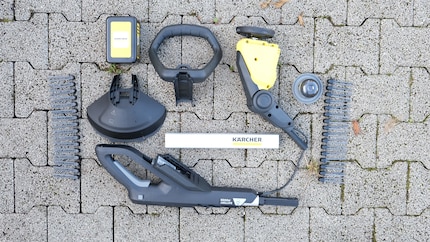
The only thing I’m briefly confused about is the band of bristles. You have to bend it into a circle and click it together. It’s placed on the bottom of the cleaning head, kind of like a crown of thorns. But you can’t clamp anything there, you just have to insert it and fix it with a cap.
Assembly finishes with a splash guard and a grip, which I slide onto the telescopic aluminium handle. A joint is built into the grip. Using the tilt feature and the telescopic handle, I can adjust the device perfectly to my height. Kärcher helps you set the angle: there are two options, one for people up to 1.77 metres and one for taller users. A third setting bends the cleaning head with the brushes at a right angle, it’s a good way to get under benches, for example.
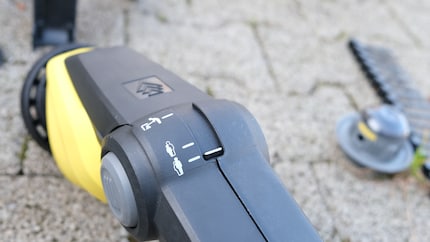
How to work with the WRE 18-55
The Kärcher weed trimmer requires electricity to start up. This is provided by a battery pack you insert into the top handle. There are two battery sizes, one with 2.5 and one with 5.0 ampere-hours. The set linked below includes the small battery. According to Kärcher, it allows you to work for 15 or 30 minutes. In my test, I managed a few minutes longer with the large battery. How long the battery lasts also depends on its age and the outside temperature. Regardless of whether the battery is large or small, the motor performs the same for both. It generates 2,300 to 2,800 revolutions per minute.
It’s fast enough for me to easily cut weeds with thicker stems. I guide the Kärcher horizontally over the surface and angle it slightly in the working direction. I don’t have to support the weight of the device all the time, but push and pull it over the plaster thanks to a plastic half circle positioned under the brush band. Safety is also taken care of: before the rotating fun begins, you have to press a button on the side to operate the handle. It prevents accidental rotation, for example when picking up the device.
I feel like a dental hygienist when I’m working. The rotating brushes remove moss from the paving stones in the same way that ultrasound removes plaque. The T-shaped pavement in our courtyard is permeable to water and has a porous surface. As a result, the nylon brushes don’t reach all the moss that’s spread.
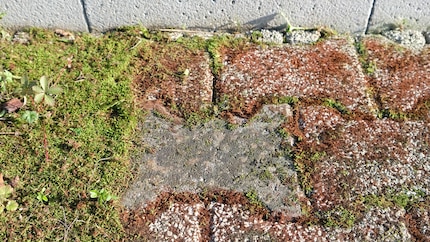
The WRE 18-55 finally reaches its limits in the joints between paving stones. Grass that grows there and has clumped together into small tufts is more likely to be tickled by the Kärcher device than be removed effectively. For a moment, I thought I even heard a few stalks laughing softly. If I set the angle steeper and really go into the joints a few times, I can at least catch some of the grass stuck there. This is made more difficult since the joints in the paving are narrow and not straight, but angled. Still, interdental spaces are also demanding.
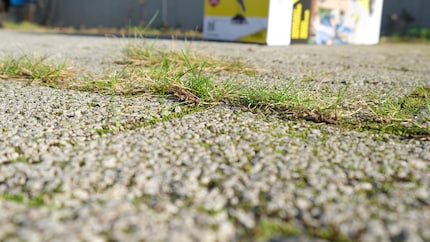
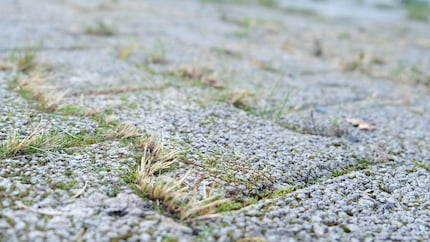
The WRE 18-55 works well against moss, the drier the better. But I can’t get to the roots of weeds. A weed scraper or a weed burner would be necessary here. After all, Kärcher itself also says the device is intended for surface cleaning. So I just brush away anything that has ventured too far out. And since weeds are defined by the fact that they’re tough and grow back, even if you don’t want them to, I know they’ll do so again in my case. That’s part of the process – just like a semi-annual teeth cleaning. (No more dental hygiene analogies from now on, I promise.)
How to protect yourself
Although the WRE 15-55 has a protective cover on the bottom of the rotating brush, I still recommend you don’t work in shorts. Plus, safety goggles aren’t a bad idea either. It’s easy for stones or grit to be whirled up and shoot around. Always remember to put on old shoes and old trousers, too. You’ll inevitably come into contact with freshly brushed, damp moss or greenery that’s still standing strong. And it’s better to move cars out of the way as long as the brush can still make things shoot around with force and possibly hit the paintwork.
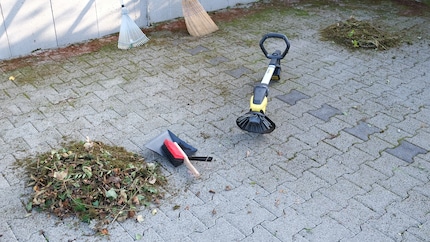
Wear and tear
Kärcher uses nylon for the brushes. This polyamide synthetic fibre is often used where great strength and durability are required. In my test, I put a lot of strain on the material by working joints with the brush head. The nylon elements hit the paving stone thousands of times, and the result is visible after just half an hour.
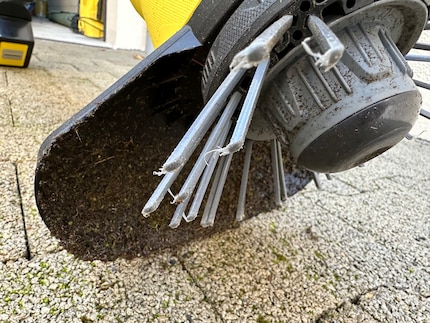
The service life would be longer if I refrained from doing this and, if at all, only accidentally hit the stone. Nevertheless, wear and tear’s unavoidable. As a result, replacement straps have to be factored in as operating costs.


Kärcher Brosse en bande WRE 18-55 3-pack
Garden machinery spare parts
The nylon brushes are problematic environmentally, as are the small plastic parts that come loose when working on joints and tiles. The keyword – microplastics. On the one hand, Kärcher boasts on its own website that it uses as much recycled plastic as possible in the manufacturing of new appliances. On the other hand, the WRE 18-55 truly is a real microplastic slinger.
In a nutshell
Standing tall in the fight against weeds
Pro
- Great at removing moss from smooth surfaces
- Self-explanatory installation and operation
- Allows you to stand up straight when removing weeds
- Brush strips can be changed quickly
- Can work wherever thanks to rechargeable battery (no cable)
Contra
- Struggles with narrow grooves
- Short battery runtime limits work you can get done
- Cost of replacement brush strips
- Spreads microplastics due to nylon brush wear
Journalist since 1997. Stopovers in Franconia (or the Franken region), Lake Constance, Obwalden, Nidwalden and Zurich. Father since 2014. Expert in editorial organisation and motivation. Focus on sustainability, home office tools, beautiful things for the home, creative toys and sports equipment.



